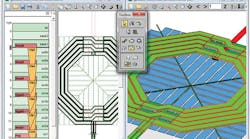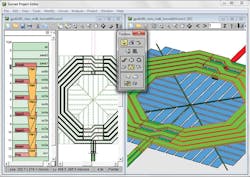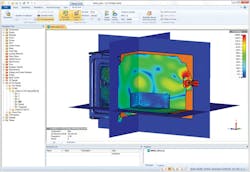This file type includes high resolution graphics and schematics when applicable.
Design software is no longer a novelty (or even a luxury) for designers of high-frequency circuits and systems. At one time, RF/microwave computer-aided-engineering (CAE) software might have been viewed as a tool to check the integrity of a design that was created more through mathematical analysis and engineering experience. But now, CAE software is an essential tool for creating new RF/microwave designs, with users placing tremendous trust in the accuracy of such design tools. The number of suppliers of CAE software has grown steadily through the years, as has the number of device models represented by their products. This has provided users with design tools that include models for many of the active and passive components they would choose to use in their circuit and system designs.
In surveying some of the currently available CAE tools, it is apparent that RF/microwave engineers now have an enormous number of software design tools from which to choose, ranging from free-of-charge packages to high-level software backed by some of the top names in the industry. Also available are a variety of modeling techniques, from simple mathematical analysis of circuit equations to full-scale three-dimensional (3D) electromagnetic (EM) modeling of circuits and circuit structures.
For example, those seeking a painless introduction to RF/microwave design software may want to consider ADIsimRF, a free downloadable software tool from Analog Devices that provides calculations for the most important parameters in the RF signal chain. These include cascaded gain, noise figure, output power at 1-dB compression, and third-order intercept point (IP3). Of course, it is written to work with and model the company’s extensive line of RF/microwave function blocks, but these components are useful for applications ranging from wireless receivers to transmitters. The software is available for free download from the company's website.
Electromagnetic (EM) simulation tools advanced a long way in the past decade, having now become primary modeling/simulation tools for many design departments. As a measure of how well established EM software tools have become, Sonnet Software recently announced Version 14 of its popular Sonnet Suites three-dimensional (3D) planar EM simulation software (Fig. 1). The company has been supplying EM design software since 1983. This latest version maintains its support for the Advanced Design System (ADS) software design tools from Agilent Technologies. It also adds many new features, including enhanced processing speed, a new Stackup Manager (which serves as a simplified operating interface), and a new inductor model extractor.
For those who would like to first explore the possibilities of using Sonnet Software tools, the firm offers a free download of the latest version (14.53) of its Sonnet Lite software. This “scaled-down” version of the company’s planar EM simulation software nonetheless provides users with an idea of the capabilities of designing with EM simulation. This latest version of Sonnet Lite allows operators to use twice as much memory for file storage, from 16 to 32 Mb, and boasts new heat flux simulation capabilities. It also includes many of the new features of Version 14 of the full-featured Sonnet Software.
Computer System Technology recently unveiled the latest version of its package of component, circuit, and system simulation tools, CST STUDIO SUITE 2014 (Fig. 2). The firm’s software has been enhanced to ease integration with other CAE tools and simplify importing models from them. CST’s System Assembly and Modeling (SAM) functionality allows multiple full-wave 3D and circuit simulations to be combined, along with analysis and optimization, and be combined into a series of automated tasks within the CST STUDIO SUITE 2014.
The firm’s diversified series of webinars provide easy-to-follow advice on using their simulation tools—including a most-recent webinar on simulating the performance and behavior of different composite materials within aircraft designs—to gain advanced knowledge of potential electromagnetic-compatibility (EMC) problems between different materials.
The RF Module for RF/microwave design from Comsol is an EM simulation software commonly used to design antennas, cavities, filters, and waveguide structures. It provides relative quick methods for computing EM field distributions, achieving impedance matching, analyzing S-parameters, and studying power dissipation. The latest version of the software allows models to include the effects of physical phenomena, such as changes in temperature and fluid flow through structures.
With its wide range of circuit and EM simulation tools, ANSYS has reached a diverse group of industries; these include aerospace/military, automotive, commercial communications, and healthcare. The firm’s EM simulators, such as the High Frequency Structure Simulator (HFSS), have become standard design tools for many high-frequency engineers, owing to their accuracy and simulation capabilities.
This file type includes high resolution graphics and schematics when applicable.
Old Standbys, New Features
This file type includes high resolution graphics and schematics when applicable.
Perhaps the two most widely used RF/microwave CAE software design packages are Agilent’s ADS and Microwave Office™ from AWR. Both companies are tireless in their attention to upgrading the software packages, with Agilent recently announcing the latest version of the system-level simulation software, SystemVue 2013.08, for ADS. This new version is capable of performing distributed simulations on Linux server farms, and now offers a new digital modem library along with enhanced libraries for radar, satellite navigation, and wireless local area networks (WLANs) systems.
Also, Agilent’s Genesys software (developed by Eagleware) provides linear and nonlinear circuit simulators, complete with 3D planar EM simulation for antennas and PCB analysis.
In addition to offering a free trial version of Microwave Office on its website, AWR recently launched a television portal from within its main website to provide hundreds of educational demonstration videos and tutorial lessons on the use of its software tools. The television portal includes video lessons on EM simulation tools, designing a GaAs monolithic-microwave-integrated-circuit (MMIC) power amplifier (PA); designing an ETSI E-band circuit for millimeter-wave wireless links; performing an integrated electro-thermal analysis and design of a silicon-germanium PA; and simulating phased antenna arrays using the firm’s Visual System Simulator™ (VSS) system-level software.
AWR’s Analog Office collection of software tools includes routines for AC and noise analysis (the HSPICE program); studying interconnection interfaces; planar 3D EM analysis of on-chip interconnections (the Analyst™ program) and on-chip passive circuit elements (the AXIEM® program); and even harmonic-balance analysis (the APLAC program).
The Pantheon software from Intercept is a low-cost simulator aimed at PCB designers, with operating interfaces to aid engineers working with schematic-based designs as well as layout-driven designs, and to simplify links to third-party analysis programs. The software enables users to create complex shapes with its graphical editing features, and supports its layouts with links to a wide range of models from other supplier’s software tools, including Agilent’s ADS and AWR’s Microwave Office tools.
Engineers willing to invest the time in exploring different software interfaces and capabilities will find an unprecedented number of free and trial versions of CAE packages on the market at the moment. Arden Technologies offers a free trial version of its SysCalc6 simulation software, complete with flexible mixer and filter models. This (normally) low-cost, simple-to-use software provides simulated data for all classical output parameters, including gain, noise figure, and output power, and they can all be related to other parameters within the same component.
Remcom offers a 30-day free trial of Release 7 of its XFdtd® EM simulation software. The 3D simulation software has been enhanced with CPU acceleration to speed calculations and with unlimited memory support for problems exceeding 60 GB. The trial version is available for free download for finite-difference, time-domain (FDTD) EM modeling and simulation.
This file type includes high resolution graphics and schematics when applicable.



